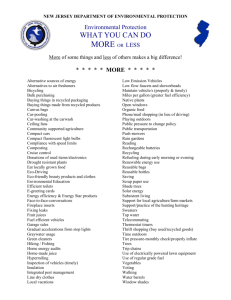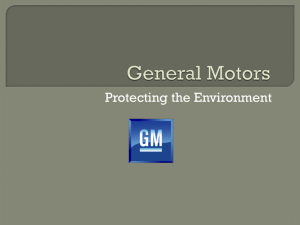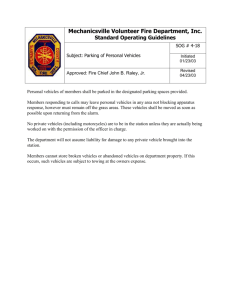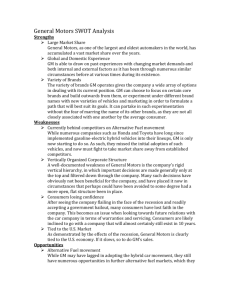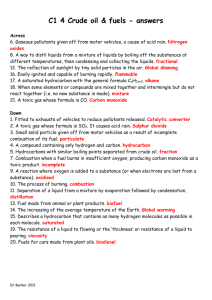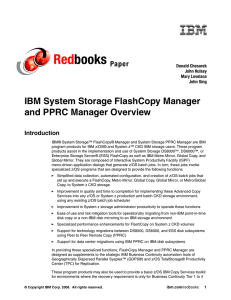view presentation
advertisement
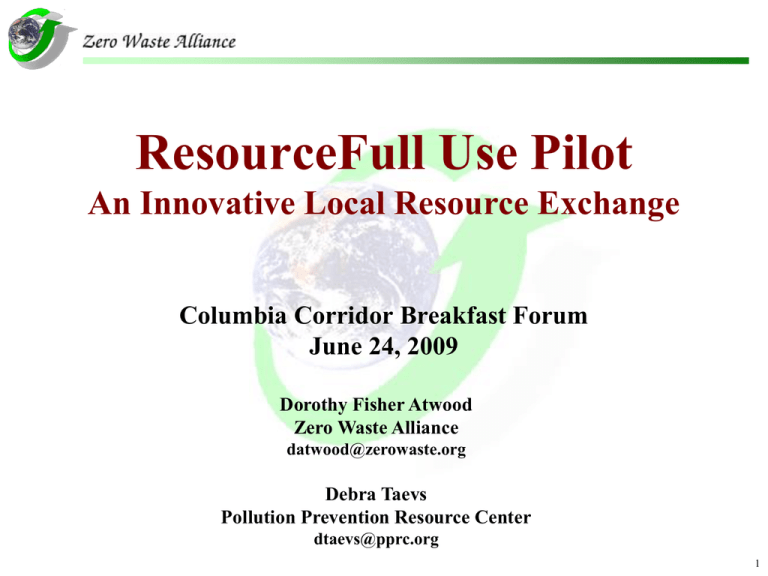
ResourceFull Use Pilot An Innovative Local Resource Exchange Columbia Corridor Breakfast Forum June 24, 2009 Dorothy Fisher Atwood Zero Waste Alliance datwood@zerowaste.org Debra Taevs Pollution Prevention Resource Center dtaevs@pprc.org 1 Agenda • • • • • • ResourceFull Use Overview What is in the waste stream environment Mapping your resource flows Case studies of resource exchanges Speed Resource Exchange “Dating” Debrief and Wrap-up 2 Zero Waste Alliance Following Nature’s model… • Our Mission is to support organizations in the creation of a more sustainable future • Formed in 1999; Larry Chalfan, Executive Director; 14 associates • Providing needed services: • Management support e.g. EMS support • Technical services • Training and education • A program of the International Sustainable Development Foundation, a 501(c)(3) non-profit www.zerowaste.org 3 Pollution Prevention Resource Center (PPRC) PPRC is the Northwest Region’s leading non-profit that provides practical, on-the-ground technical assistance to businesses, public agencies, and non-profits that are seeking to conserve resources and improve economic performance PPRC • Est. in 1990 as an alternative to building new hazardous waste disposal sites in the region • Serve EPA Region 10 (WA, OR, ID and AK) • Provide pollution prevention (P2) information resources, research and networking • Support for Technical Service Providers in federal, state and local government and industry Industrial Ecology “A Rose by any other name would still smell as sweet…” Shakespeare's Romeo and Juliet, 1594 • • • • By-Product Synergy Materials Exchange Beneficial Use Resourceful Use Image courtesy of http://stantonssheetmusic.wordpress.com/2009/04/ Principle: Garbage in, Something of value out, or like Rumplestiltskin, spinning straw into gold! Anne Anderson, illustrator. Anne Anderson's Old, Old Fairy Tales. Racine, Wisconsin: Whitman Publishing Company, 1935. ResourceFull Use Overview 8 ResourceFull Use Overview 9 What’s still in the waste stream?? What’s still in the waste stream?? Creating an Input-Output Diagram Step 1. Define your ‘fenceline’ with key operations Step 2. Identify key activities for each operation Step 3. Identify inputs and outputs of each activity and associated environmental impacts 12 Step 1 - Define your Fenceline Create Top Level Input/Output (I/O) Diagram fenceline Resources The Organization Operations Products By-products Waste 13 Steps 2 and 3: Identify Key Activities Create I/O Diagram for Each Operation Resources Operation Activities Products By-products Waste 14 Clark County Public Works Fenceline Vehicle Maintenance Yard Resources • New vehicles • Vehicle fuel (B20 and gasoline) • Lubricants • Service parts • Misc. shop supplies • Tools and equip. • Office supplies • Water • Electricity • Nat. gas Waste Operations Management & Procurement Facilities Management Fuel Islands Emergency Service Heavy Equipment • Combustion gasses • Used parts (some) • Used spill clean up materials Light Vehicles Fabrication Parts Mark Ready Acquisition Remote Fueling • Trash • Haz. Waste Products • Transportation services, mobility • Vehicles maintained By-products • • • • • • Used vehicles Scrapped vehicles Used parts (rebuild) Used oils Scrap metal Cardboard, paper 15 Clark County Public Works Operation Remote Fueling Activities Resources • • • • • • B20 diesel fuel Motor oil Hydraulic oil Antifreeze ATF Spill clean up matls • Service parts • Filters • Rags • • • • • • Filling bulk tanks on truck Driving truck around Dispensing from truck Remote servicing of vehicles Fueling the truck Spill clean up Waste • • • • Evaporated fuel Combustion gasses Used parts (some) Used spill clean up materials Products • Fueled and serviced vehicles By-products • Used parts (some) • Used filters • Used motor oil & ATF • Dirty rags 16 Resources, Products, By-products, Waste Inputs Resources include: • Materials (delivered) • Metals, Plastics • Paper, Wood, Packaging • Chemicals, Process Gasses • Oil, Coal, Gasoline, LPG, Diesel • Sunlight, Rainwater • Utilities (“piped”) • Water • Electricity • Natural Gas • Human • Work Time • Thoughts, Creativity • Morale (efficiency) • Health, family Outputs Products include: Products include: • •Tangible Products Tangible Products • •Services Services By-products: (a type of waste) Waste (everything else), including: • Secondary Products • Air Emissions •• Recyclable Materials Waste Water, Storm Water Waste (everything in else), including: • Contaminants Waste Water •• Air Emissions Heat, Sunlight, Rainwater •• Waste Water, Storm Water “Solid”, Municipal Waste •• Contaminants in Waste Water Hazardous Waste •• Heat, Rainwater Time,Sunlight, Absenteeism, Inefficiency • “Solid”, Municipal Waste • Hazardous Waste • Time, Absenteeism, Inefficiency 17 Three Case Studies 1. Northwest By-Product Synergy Network (Puget Sound) 2. Eastern Washington Industrial Materials Exchange (Tri-Cities) 3. UK example Northwest By-Product Synergy Network • Est. 2007 • U.S. Business Council for Sustainable Development model • Facilitated approach • Paying members • Puget Sound focus • Approx 15 Organizations Charter Members • • • • • • • Canyon Creek Cabinets Cascade Designs ConocoPhillips Cook Composites and Polymers Genie Industries Grays Harbor Paper Company King County Department of Natural Resources and Parks • Solid Waste Division • LaFarge Cement • Leader International • • • • • • Nucor Steel Phillips Services Port of Seattle Seattle Public Utilities Shell Puget Sound Refinery Snohomish County Public Works • Terra Matters • Tri-Vitro Corporation Network Activities • • • • • Large Community Meetings Membership Confidentiality Targeted working groups Regulatory advisors NW BPS has documented the following savings • $393,000+ annual savings • 2,489 metric tons CO2 equivalent emissions avoided annually • 3,663 tons of material diverted annually • 66+ tons of material not purchased Eastern WA Industrial Materials Exchange • Sponsored by Boise Paper • Initially facilitated by PPRC • Grass roots • Ag community • Approx 20 participants • “Speed Dating”! Eastern WA Industrial Materials Exchange Companies included; • Furniture company • Wineries • Fertilizer manufacturing • Animal feed • Other manufacturing • Landscapers, etc Eastern WA Industrial Materials Exchange (Ray Lam) Reuse metals and wire -used to recycle • Don’t purchase what we have in the recycle bins – stainless piping • $1.50 received vs. $7.50 paid per lb for stainless pipe • Selling copper wire back as wire vs. copper • Selling papermachine felts$50/each vs. disposal Tallow • Material was soaked into chips and dried for a day, and used as fuel • Neighbor avoided about $1,000,000 in landfill fees • Received about $250 K in fuel National Industrial Symbiosis Project U.K. NISP is a free business opportunity programme that delivers bottom line, environmental and social benefits and is the first industrial symbiosis initiative in the world to be launched on a national scale. NISP • Most successful exchange project in world? • Gov’t funded • No barrier to participation • Now in it’s 5th year • DEFTRA funds 5 million (British Pound)/year= $8,132,415 Dollars NISP Results May 09 Press Release • Reduced national industrial carbon emissions 5.2 million tonnes • Diverted 5.2 million tonnes of industrial waste • Prevented the use of 7.9 tonnes of virgin materials • Attracted £116 million in private investment in reprocessing and recycling • Generated £151 new sales for members • Saved £131 for members • Eliminated 357,000 tonnes of hazardous waste • Saved 9.4 million gallons of industrial wastewater Speed Resource Exchange Dating 29 Contact: Dorothy Fisher Atwood Debra Taevs Associate Debuty Director One World Trade Center 121 S.W. Salmon St., Ste 210 Portland, OR 97204 Tel: 503-699-7834 Fax: 503-279-9381 PPRC……. datwood@zerowaste.org www.zerowaste.org 30

